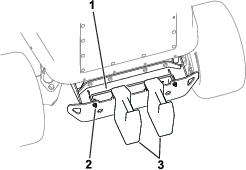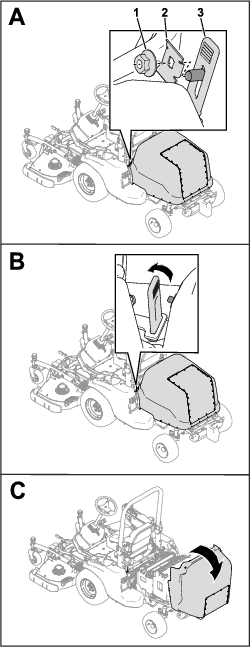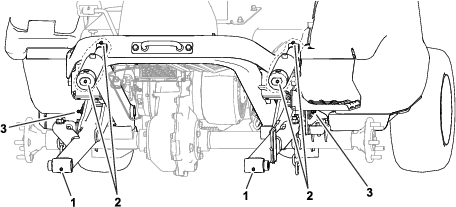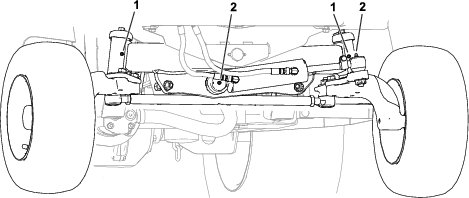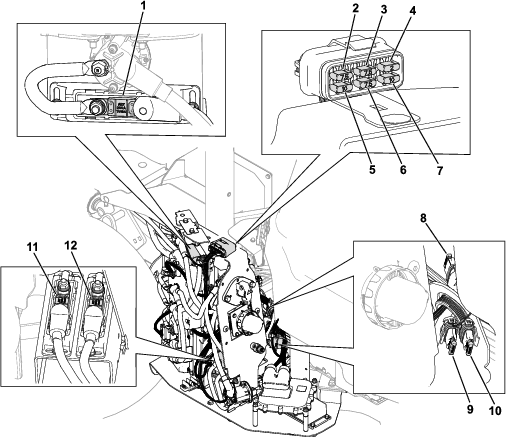| Maintenance Service Interval | Maintenance Procedure |
|---|---|
| Before each use or daily |
|
Introduction
This machine is a ride-on, rotary-blade lawnmower intended to be used by professional, hired operators in commercial applications. It is designed primarily for maintaining grass on well-maintained lawns in parks, sports fields, and on commercial grounds. Using this product for purposes other than its intended use could prove dangerous to you and bystanders.
Read this information carefully to learn how to operate and maintain your product properly and to avoid injury and product damage. You are responsible for operating the product properly and safely.
Visit www.Toro.com for product safety and operation training materials, accessory information, help finding a dealer, or to register your product.
Whenever you need service, genuine Toro parts, or additional information, contact an Authorized Service Dealer or Toro Customer Service and have the model and serial numbers of your product ready. Figure 1 identifies the location of the model and serial numbers on the product. Write the numbers in the space provided.
Important: With your mobile device, you can scan the QR code on the serial number decal (if equipped) to access warranty, parts, and other product information.
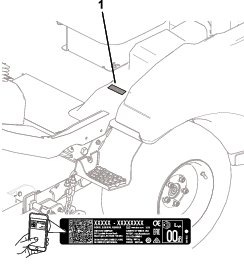
This product complies with all relevant European directives; for details, please see the separate product specific Declaration of Conformity (DOC) sheet.
Warning
CALIFORNIA
Proposition 65 Warning
The power cord on this product contains lead, a chemical known to the State of California to cause birth defects or other reproductive harm. Wash hands after handling.
Battery posts, terminals, and related accessories contain lead and lead compounds, chemicals known to the State of California to cause cancer and reproductive harm. Wash hands after handling.
Use of this product may cause exposure to chemicals known to the State of California to cause cancer, birth defects, or other reproductive harm.
Safety
General Machine Safety Warnings
 WARNING—Read all safety warnings, instructions, illustrations
and specifications provided with this machine.
WARNING—Read all safety warnings, instructions, illustrations
and specifications provided with this machine.
Failure to follow the warnings and instructions may result in electric shock, fire and/or serious injury.
The term “machine” in all of the warnings listed below refers to your mains-operated (corded) machine or battery-operated (cordless) machine.
-
Work area safety
-
Keep work area clean and well lit.Cluttered or dark areas invite accidents.
-
Do not operate the machine in explosive atmospheres, such as in the presence of flammable liquids, gasses, or dust.The machine creates sparks, which may ignite the dust or fumes.
-
Keep children and bystanders away while operating the machine.Distractions can cause you to lose control.
-
-
Electrical safety
-
Machine plugs must match the outlet. Never modify the plug in any way. Do not use any adapter plugs with an earthed (grounded) machine.Unmodified plugs and matching outlets will reduce risk of electric shock.
-
Avoid body contact with earthed or grounded surfaces, such as pipes, radiators, ranges, and refrigerators.There is an increased risk of electric shock if your body is earthed or grounded.
-
Do not expose the machine to rain or wet conditions.Water entering a machine will increase the risk of electric shock.
-
Do not abuse the cord. Never use the cord for carrying, pulling or unplugging the machine. Keep cord away from heat, oil, sharp edges, or moving parts.Damaged or entangled cords increase the risk of electric shock.
-
When operating the machine outdoors, use an extension cord suitable for outdoor use.Use of a cord suitable for outdoor use reduces the risk of electric shock.
-
If operating the machine in a damp location is unavoidable, use a residual current device (RCD) protected supply.Use of an RCD reduces the risk of electric shock.
-
-
Personal safety
-
Stay alert, watch what you are doing, and use common sense when operating the machine. Do not use the machine while you are tired or under the influence of drugs, alcohol, or medication.A moment of inattention while operating the machine may result in serious personal injury.
-
Use personal protective equipment. Always wear eye protection.Protective equipment such as a dust mask, non-skid safety shoes, or hearing protection used for appropriate conditions will reduce personal injuries.
-
Prevent unintentional starting. Ensure the switch is in the off-position before connecting to power source and/or battery pack.Energising a machine that has the switch on invites accidents.
-
Remove any adjusting key or wrench before turning the machine on.A wrench or a key left attached to a rotating part of the machine may result in personal injury.
-
Do not overreach. Keep proper footing and balance at all times.This enables better control of the machine in unexpected situations.
-
Dress properly. Do not wear loose clothing or jewelry. Keep your hair and clothing away from moving parts.Loose clothes, jewelry or long hair can be caught in moving parts.
-
If devices are provided for the connection of dust extraction and collection facilities, ensure these are connected and properly used.Use of dust collection can reduce dust-related hazards.
-
Do not let familiarity gained from frequent use of the machine allow you to become complacent and ignore machine safety principles.A careless action can cause severe injury within a fraction of a second.
-
-
Machine use and care
-
Do not force the machine. Use the correct machine for your application.The correct machine will do the job better and safer at the rate for which it was designed.
-
Do not use the machine if the switch does not turn it on and off.Any machine that cannot be controlled with the switch is dangerous and must be repaired.
-
Disconnect the plug from the power source and/or remove the battery pack, if detachable, from the machine before making any adjustments, changing accessories, or storing the machine.Such preventive safety measures reduce the risk of starting the machine accidentally.
-
Store an idle machine out of the reach of children and do not allow persons unfamiliar with the machine or these instructions to operate the machine.A machine is dangerous in the hands of untrained users.
-
Maintain the machine and accessories. Check for misalignment or binding of moving parts, breakage of parts and any other condition that may affect the operation of the machine. If damaged, have the machine repaired before use.Many accidents are caused by a poorly maintained machine.
-
Keep cutting tools sharp and clean.Properly maintained cutting tools with sharp cutting edges are less likely to bind and are easier to control.
-
Use the machine, accessories, and tool bits etc., in accordance with these instructions, taking into account the working conditions and the work to be performed.Use of the machine for operations different from those intended could result in a hazardous situation.
-
Keep handles and grasping surfaces dry, clean and free from oil and grease.Slippery handles and grasping surfaces do not allow for safe handling and control of the machine in unexpected situations.
-
-
Battery machine use and care
-
Recharge only with the charger specified by a manufacturer.A charger that is suitable for one type of battery pack may create a risk of fire when used with another battery pack.
-
Use the machine only with specifically designated batteries.Use of any other batteries may create a risk of injury and fire.
-
When battery pack is not in use, keep it away from other metal objects, like paper clips, coins, keys, nails, screws or other small metal objects, that can make a connection from one terminal to another.Shorting the battery terminals together may cause burns or a fire.
-
Under abusive conditions, liquid may be ejected from the battery; avoid contact. If contact accidentally occurs, flush with water. If liquid contacts eyes, additionally seek medical help.Liquid ejected from the battery may cause irritation or burns.
-
Do not use a battery pack or machine that is damaged or modified.Damaged or modified batteries may exhibit unpredictable behavior resulting in fire, explosion or risk or injury.
-
Do not expose a battery pack or machine to fire or excessive temperature.Exposure to fire temperature above 130°C may cause an explosion.
-
Follow all charging instructions and do not charge the battery pack or machine outside the temperature range specified in the instructions.Charging improperly or at temperatures outside the specified range may damage the battery and increase the risk of fire.
-
-
Service
-
Have your machine serviced by a qualified repair person using only identical replacement parts.This will ensure that the safety of the machine is maintained.
-
Never service damaged battery packs.Service of battery packs should be performed only by the manufacturer or authorized service providers.
-
Additional Safety Messages
Safety-Alert Symbol
The safety-alert symbol (Figure 2) shown in this manual and on the machine identifies important safety messages that you must follow to prevent accidents.

The safety-alert symbol appears above information that alerts you to unsafe actions or situations and is followed by the word DANGER, WARNING, or CAUTION.
DANGER indicates an imminently hazardous situation which, if not avoided, will result in death or serious injury.
WARNING indicates a potentially hazardous situation which, if not avoided, could result in death or serious injury.
CAUTION indicates a potentially hazardous situation which, if not avoided, may result in minor or moderate injury.
This manual uses two other words to highlight information. Important calls attention to special mechanical information and Note emphasizes general information worthy of special attention.
General Safety
This product is capable of amputating hands and feet and of throwing objects. Always follow all safety instructions to avoid serious personal injury.
-
Do not operate the machine without all guards and other safety protective devices in place and functioning properly on the machine.
-
Keep your hands and feet away from rotating parts. Keep clear of the discharge opening.
-
Never allow children to operate the machine.
-
Shut off the machine, remove the key, and wait for all movement to stop before you leave the operator’s position. Allow the machine to cool before adjusting, servicing, cleaning, or storing it.
Operation Safety
-
The owner is responsible for training all operators.
-
Become familiar with the safe operation of the equipment, operator controls, and safety signs.
-
This product generates an electromagnetic field. If you wear an implantable electronic medical device, consult your health care professional before using this product.
-
Shut off the machine, remove the key, and wait for all movement to stop before you leave the operator’s position. Turn the battery-disconnect switch to the OFF position and allow the machine to cool before adjusting, servicing, cleaning, or storing it.
-
Know how to stop and shut off the machine quickly.
-
Check that operator-presence controls, safety switches, and guards are attached and functioning properly. Do not operate the machine unless they are functioning properly.
-
Before mowing, always inspect the machine to ensure that the blades, blade bolts, and cutting assemblies are in good working condition. Replace worn or damaged blades and bolts in sets to preserve balance.
-
Inspect the area where you will use the machine and remove all objects that the machine could throw.
-
The owner/operator can prevent and is responsible for accidents that may cause personal injury or property damage.
-
Wear appropriate clothing, including eye protection; long pants; substantial, slip-resistant footwear; and hearing protection. Tie back long hair and do not wear loose clothing or loose jewelry.
-
Before you start the machine, ensure that all drives are in neutral and you are in the operating position.
-
Do not carry passengers on the machine.
-
Operate the machine only in good visibility to avoid holes or hidden hazards.
-
Avoid mowing on wet grass. Reduced traction could cause the machine to slide.
-
Keep your hands and feet away from rotating parts. Keep clear of the discharge opening.
-
Look behind and down before backing up to be sure of a clear path.
-
Use care when approaching blind corners, shrubs, trees, or other objects that may obscure your vision.
-
Stop the blades whenever you are not mowing.
-
Stop the machine, remove the key, and wait for all moving parts to stop before inspecting the attachment after striking an object or if there is an abnormal vibration in the machine. Turn the battery-disconnect switch to the OFF position and make all necessary repairs before resuming operation.
-
Slow down and use caution when making turns and crossing roads and sidewalks with the machine. Always yield the right-of-way.
-
Disengage the drive to the cutting unit, shut off the machine, remove the key, and wait for all movement to stop before adjusting the height of cut (unless you can adjust it from the operating position).
-
Never leave a running machine unattended.
-
Before you leave the operator’s position, do the following:
-
Park the machine on a level surface.
-
Ensure that the parking brake is engaged.
-
Disengage the power takeoff and lower the attachments.
-
Shut off the machine and remove the key.
-
Wait for all movement to stop.
-
-
Do not operate the machine when there is the risk of lightning.
-
Do not use the machine as a towing vehicle.
-
Use accessories, attachments, and replacement parts approved by Toro only.
-
The ROPS is an integral and effective safety device.
-
Do not remove any of the ROPS components from the machine.
-
Ensure that the seat belt is attached to the machine.
-
Pull the belt strap over your lap and connect the belt to the buckle on the other side of the seat.
-
To disconnect the seat belt, hold the belt, press the buckle button to release the belt, and guide the belt into the auto-retract opening. Ensure that you can release the belt quickly in an emergency.
-
Check carefully for overhead obstructions and do not contact them.
-
Keep the ROPS in safe operating condition by thoroughly inspecting it periodically for damage and keeping all the mounting fasteners tight.
-
Replace damaged ROPS components. Do not repair or alter them.
-
A cab installed by Toro is a roll bar.
-
Always wear your seat belt.
-
Keep a folding roll bar in the raised and locked position, and wear your seat belt when operating the machine with the roll bar in the raised position.
-
Lower a folding roll bar temporarily only when necessary. Do not wear the seat belt when the roll bar is folded down.
-
Be aware that there is no rollover protection when a folded roll bar is in the down position.
-
Check the area that you will be mowing and never fold down a folding roll bar in areas where there are slopes, drop-offs, or water.
-
Slopes are a major factor related to loss of control and rollover accidents, which can result in severe injury or death. You are responsible for safe slope operation. Operating the machine on any slope requires extra caution.
-
Evaluate the site conditions to determine if the slope is safe for machine operation, including surveying the site. Always use common sense and good judgment when performing this survey.
-
Review the slope instructions listed below for operating the machine on slopes and to determine whether you can operate the machine in the conditions on that day and at that site. Changes in the terrain can result in a change in slope operation for the machine.
-
Avoid starting, stopping, or turning the machine on slopes. Avoid making sudden changes in speed or direction. Make turns slowly and gradually.
-
Do not operate a machine under any conditions where traction, steering, or stability is in question.
-
Remove or mark obstructions such as ditches, holes, ruts, bumps, rocks, or other hidden hazards. Tall grass can hide obstructions. Uneven terrain could overturn the machine.
-
Be aware that operating the machine on wet grass, across slopes, or downhill may cause the machine to lose traction. Loss of traction to the drive wheels may result in sliding and a loss of braking and steering.
-
Use extreme caution when operating the machine near drop-offs, ditches, embankments, water hazards, or other hazards. The machine could suddenly roll over if a wheel goes over the edge or the edge caves in. Establish a safety area between the machine and any hazard.
-
Identify hazards at the base of the slope. If there are hazards, mow the slope with a pedestrian-controlled machine.
-
If possible, keep the cutting unit(s) lowered to the ground while operating on slopes. Raising the cutting unit(s) while operating on slopes can cause the machine to become unstable.
-
Use extreme caution with grass-collection systems or other attachments. These can change the stability of the machine and cause a loss of control.
-
Shut off the machine, remove the key, and wait for all movement to stop before you leave the operator’s position. Allow the machine to cool before adjusting, servicing, cleaning, or storing it.
-
Clean grass and debris from the cutting units to help prevent fires.
-
If the cutting units are in the transport position, use the positive mechanical lock (if available) before you leave the machine unattended.
-
Allow the machine to cool before storing the machine in any enclosure.
-
Remove the key before storing or hauling the machine.
-
Never store the machine where there is an open flame, spark, or pilot light, such as on a water heater or on other appliances.
-
Maintain and clean the seat belt(s) as necessary.
Battery and Charger Safety
General
WARNING: Risk of fire and electric shock—The batteries have no user-serviceable parts.
-
Confirm the voltage that is available in your country before using the charger.
-
Do not charge the machine in a wet environment; keep it protected from rain and snow.
-
A risk of fire, electric shock, or injury may result from using an accessory not recommended or sold by Toro.
-
To reduce risk of a battery explosion, follow these instructions and the instructions for any equipment that you intend to use near the charger.
-
Batteries could emit explosive gasses if they are significantly overcharged.
-
Refer to an authorized Toro distributor to service or replace a battery.
Training
-
Never allow children or untrained people to operate or service the charger. Local regulations may restrict the age of the operator. The owner is responsible for training all operators and mechanics.
-
Read, understand, and follow all instructions on the charger and in the manual before operating the charger. Be familiar with the proper use of the charger.
Preparation
-
Keep bystanders and children away while charging.
-
Use the charger only within the voltage range specified in this Operator's Manual, and use only a power cord approved by Toro.
-
Contact your authorized Toro distributor for the proper charger and power cord.
Operation
-
Do not charge a frozen battery.
-
Do not abuse the cord. Do not pull on the power supply cord to disconnect the charger from the receptacle. Store the cord away from heat, oil, and sharp edges.
-
Connect the charger directly to a grounded receptacle. Do not use the charger on an ungrounded outlet, even with a grounding adapter.
-
Do not alter the provided power cord or plug.
-
Remove metal items such as rings, bracelets, necklaces, and watches when working with a lithium-ion battery. A lithium-ion battery can produce enough current to cause a severe burn.
-
Use an extension cord that can handle the charging amperage specified in this Operator's Manual. If you are charging outdoors, use an extension cord rated for outdoor use.
-
If the power supply cord is damaged while it is plugged in, disconnect the cord from the wall receptacle and contact an authorized Toro distributor for a replacement.
-
Unplug the charger from the electrical outlet when not in use, before moving it to another location, or prior to servicing it.
Maintenance and Storage
-
Do not disassemble the charger.
-
Take the charger to an authorized Toro distributor when service or repair is required.
-
Unplug the power cord from the outlet before starting any maintenance or cleaning to reduce risk of electric shock.
-
Maintain or replace safety and instruction labels as needed.
-
Do not operate the charger with a damaged cord or plug. Contact an authorized Toro distributor to obtain a replacement cord.
-
If the charger is damaged, do not use it; take it to an authorized Toro distributor.
Maintenance Safety
-
Before you leave the operator’s position, do the following:
-
Park the machine on a level surface.
-
Ensure that the parking brake is engaged.
-
Disengage the power takeoff and lower the attachments.
-
Shut off the machine and remove the key.
-
Wait for all movement to stop.
-
-
If you leave the key in the switch, someone could accidently start the machine and seriously injure you or other bystanders. Remove the key from the switch before you perform any maintenance.
-
Allow machine components to cool before performing maintenance.
-
If the cutting units are in the transport position, use the positive mechanical lock (if equipped) before you leave the machine unattended.
-
If possible, do not perform maintenance while the machine is running. Keep away from moving parts.
-
Support the machine with jack stands whenever you work under the machine.
-
Use insulated tools whenever you service high voltage components in the electrical system.
-
Carefully release pressure from components with stored energy.
-
Keep all parts of the machine in good working condition and all hardware tightened, especially blade-attachment hardware.
-
Replace all worn or damaged decals.
-
To ensure safe, optimal performance of the machine, use only genuine Toro replacement parts. Replacement parts made by other manufacturers could be dangerous, and such use could void the product warranty.
-
Never allow children or untrained people to service the machine. The owner is responsible for training all mechanics.
-
Seek immediate medical attention if fluid is injected into skin. Injected fluid must be surgically removed within a few hours by a doctor.
-
Ensure that all hydraulic-fluid hoses and lines are in good condition and all hydraulic connections and fittings are tight before applying pressure to the hydraulic system.
-
Keep your body and hands away from pinhole leaks or nozzles that eject high-pressure hydraulic fluid.
-
Use cardboard or paper to find hydraulic leaks.
-
Safely relieve all pressure in the hydraulic system before performing any work on the hydraulic system.
-
After servicing the machine, test the machine in an open area away from bystanders to ensure that the machine is operating properly.
Storage Safety
-
Ensure that the parking brake is engaged, shut off the machine, remove the key, and wait for all movement to stop before you leave the operator’s position. Allow the machine to cool before adjusting, servicing, cleaning, or storing it.
-
Never store the machine where there is an open flame, spark, or pilot light.
Safety and Instructional Decals
 |
Safety decals and instructions are easily visible to the operator and are located near any area of potential danger. Replace any decal that is damaged or missing. |



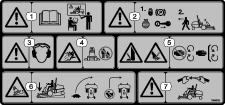

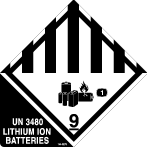

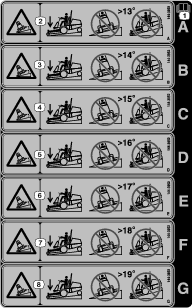

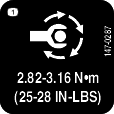


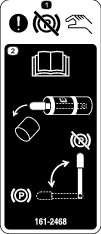


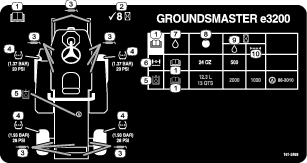
Setup
Removing the Machine from the Shipping Container
-
Remove the screws that hold down the rear-wheel hubs to the pallet.
-
Remove the rear wheels from the shipping skid.
-
Raise the roll bar; refer to Raising the Roll Bar.
-
Connect a hoist to the top, center area of the roll bar and raise the machine.
-
Remove the shipping skid from the bottom area of the machine.
-
Position 2 jack stands under the rear area of the machine shown in Raising the Rear of the Machine.
-
Lower the machine on the jack stands.
Installing the Rear Tires
Parts needed for this procedure:
| Rear wheel | 2 |
| Small washer | 2 |
| Large washer | 2 |
| Bolt (5/8 x 1-1/4 inch) | 2 |
| Dust cap | 2 |
| Thread-locking compound |
-
Remove the shipping bracket from the axle spindle or wheel hub and discard the bracket.
-
Remove the tires from the shipping container and retain the 2 bolts (5/8 x 1-1/4 inch) and large washers that secured the tires to the container.
-
Apply thread-locking compound to the internal threads in the axle spindle (Figure 3).
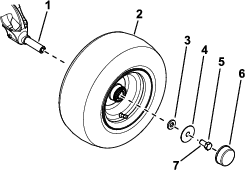
-
Use a small washer, large washer, bolt (5/8 x 1-1/4 inch), and to secure the wheel to the axle spindle (Figure 3).
-
Torque the bolt to 203 N∙m (150 ft-lb).
-
Install the dust cap to the wheel (Figure 3).
Removing the Front Tires
Installing the Lift-Arm Assembly
Parts needed for this procedure:
| Right lift arm | 1 |
| Left lift arm | 1 |
| Large pin | 2 |
| Bolt (5/16 x 1 inch) | 2 |
| Nut (5/16 x 1 inch) | 2 |
| Nut (3/8 inch) | 2 |
| Small pin | 2 |
| Bolt (3/8 x 1-1/4 inches) | 2 |
| Grease fitting | 2 |
Note: Have an assistant help you to install the lift arms as needed.
-
Remove the lift arms from the shipping skid.
-
Use 2 large pins to install the lift arms to the machine frame (Figure 5).
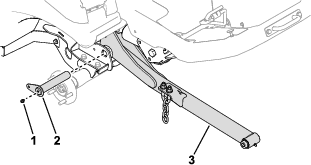
-
Install the grease fittings to the large pins (Figure 5).
-
Use 2 nuts (5/16 inch) and 2 bolts (5/16 x 1 inch) to secure the large pins to the frame (Figure 6).
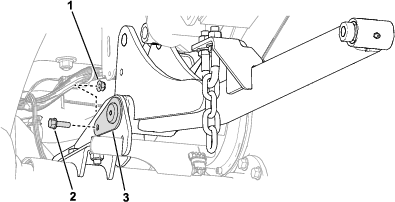
-
Perform the following steps to secure the hydraulic cylinders to the lift arms:
-
Use the display screen to ensure that the counterbalance setting is set to OFF.
-
Use a drift punch to align the cylinder rod holes with the lift-arm holes (Figure 7).
Note: Fully raise the lift arm to help with the alignment.

-
Use 2 bolts (3/8 x 1-1/4 inches), 2 nuts (3/8 inch), and 2 small pins to secure the lift arms to the cylinders (Figure 7).
-
-
Grease the attachment pin joints and lift-arm pin joints; refer to Greasing the Bearings and Bushings.
Installing the Front Tires
-
Use the previously-removed lug nuts to secure the tires to the wheel hubs (Figure 8).
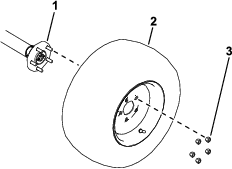
-
Torque the wheel lug nuts; refer to Torquing the Wheel Lug Nuts.
Installing the Tie-Down Bracket
Parts needed for this procedure:
| Tie-down bracket | 1 |
| Bolt (3/8 x 3-1/4 inches) | 2 |
| Nut (3/8 inch) | 2 |
Use 2 bolts (3/8 x 3-1/4 inches) and 2 nuts (3/8 inch) to secure the tie-down bracket to the platform (Figure 9).
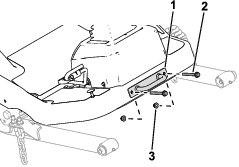
Installing the Seat
Parts needed for this procedure:
| Seat Kit (ordered separately; refer to your authorized Toro distributor) | 1 |
Install the seat; refer to the Seat Kit Installation Instructions.
Installing the Steering Wheel
Parts needed for this procedure:
| Steering wheel | 1 |
| Cover | 1 |
-
Remove the steering wheel from the shipping skid (Figure 10).
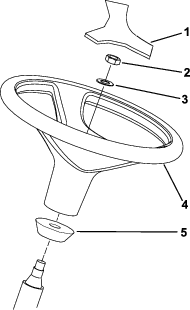
-
Remove the nylock nut and washer from the steering shaft.
Note: Ensure that the foam collar remains on the steering shaft (Figure 10).
-
Slide the steering wheel and washer onto the steering shaft (Figure 10).
-
Use the nylock nut to secure the steering wheel to the shaft. Tighten the nylock nut to 27 to 35 N∙m (20 to 26 ft-lb).
-
Mount the cover to the steering wheel (Figure 10).
Installing the Bumper
Parts needed for this procedure:
| Bumper | 1 |
| Bolt (3/8 x 2-3/4 inches) | 2 |
| Bolt (3/8 x 3-1/4 inches) | 4 |
| Nut (3/8 inch) | 6 |
-
Remove the bumper from the shipping skid.
-
Remove and retain the 2 bolts (3/8 x 2-3/4 inches) and 2 nuts (3/8 inch) that secure the rear battery tray to the frame (Figure 11).
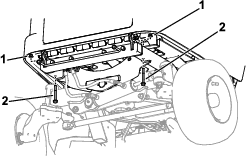
-
Loosely secure the upper area of the bumper to the machine frame using 4 bolts (3/8 x 3-1/4 inches) and 4 nuts (3/8 inch) as shown in Figure 12.
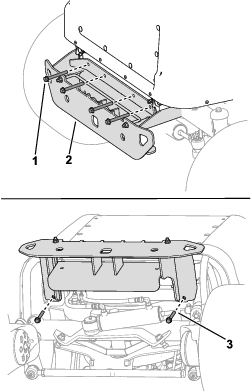
-
Loosely secure the bumper under the machine frame using 2 bolts (3/8 x 2-3/4 inches) and 2 nuts (3/8 inch) as shown in Figure 12.
-
Tighten the hardware.
Adjusting the Roll-Bar Position
Raise the roll bar; refer to Raising the Roll Bar.
Installing the Cutting Unit
Parts needed for this procedure:
| Cutting unit (ordered separately; refer to your authorized Toro distributor) | 1 |
Install the cutting unit; perform the following steps and refer to your cutting unit Operator’s Manual for additional installation instructions.
-
Have an assistant sit in the seat, turn the key to the ON position, and use the attachment lift switch to lower the lift arms while you push down on the lift arms.
-
Align the holes in the lift arm with the holes in the attachment arm as described in the cutting unit Operator’s Manual.
-
Connect the cutting-unit connector to the machine connector as described in the cutting unit Operator’s Manual.
Installing a Plug to the Flying-Lead Cord
Parts needed for this procedure:
| Flying lead power-supply cord | 1 |
Perform this procedure if you must use the flying-lead cord as your power-supply cord (Figure 13) to charge the machine.

-
Select a plug that has the following characteristics:
-
Minimum current rating: 16 A
-
Rated for 250 V
-
-
Install the plug per the plug manufacturer Installation Instructions.
Refer to the following table for the corresponding wire color and circuit:
Wire Color Circuit Green Ground White Neutral Black Line
Charging the Machine
Parts needed for this procedure:
| Power-supply cord (ordered separately; refer to your authorized Toro distributor) | 1 |
-
Refer to your authorized Toro distributor for the appropriate power-supply cord that can be used in your country.
-
Charge the machine; refer to Charging the Lithium-Ion Batteries.
Checking the Hydraulic-Fluid Level
Check the hydraulic-fluid level; refer to Checking the Hydraulic-Fluid Level.
Checking the Tire Pressure
Check the tire pressure; refer to Checking the Tire Air Pressure.
Installing the Sound and Slope Decals
Parts needed for this procedure:
| Sound decal | 1 |
| Slope decal | 1 |
If you use this machine in a country that complies to CE or UKCA standards, apply the sound and slope decals as follows:
-
Sound decal: Perform the following steps to install the decal:
-
Use the following table to determine which sound decal is applicable for your equipped cutting unit and cutting-unit blades:
Cutting Unit Model Number Equipped Blade Part Number Sound Decal 31890 145-1114 or 147-2082 97 db 145-1115 or 145-1116 102 db 31891 145-1114 or 147-2082 97 db 145-1115 or 145-1116 102 db -
Apply the appropriate decal in the area near the serial plate as shown in Figure 14.
-
-
Slope decal: Perform the following steps to install the decal:
-
Use the following table to determine which slope-decal letter is applicable for your equipped cutting unit:
Cutting Unit Model Number Total Number of Batteries Installed Slope Decal* 31890 or 31891 11 or 13 C 15 or 17 C *Meets the required slope standard when equipped with the appropriate amount of rear weight as detailed in this Operator’s Manual. -
Peel the appropriate slope decal from the backing and discard the remaining decals.
-
Apply over the area of the warning decal as shown in Figure 14.
-
Important: Ensure that the application surfaces shown in Figure 14 are clean and dry before you apply the decals.

Installing Rear Weight
Parts needed for this procedure:
| Weight (amount varies per your battery configuration) |
The machine is shipped with 2 weights (19 kg or 42 lb). If your machine is equipped with 11 batteries or will be equipped with 13 batteries, perform the following steps to install the 2 weights to the bumper:
Note: For machines that will be equipped with 15 or 17 batteries, refer to the Energy Expansion Kit Installation Instructions for rear weight information.
Installing an Energy Expansion Kit
Parts needed for this procedure:
| Energy Expansion Kit (ordered separately; refer to your authorized Toro distributor) |
Depending on your work application, you may need to install an Energy Expansion Kit to increase the number of equipped batteries on your traction unit. Refer to your authorized Toro distributor for these kits.
Note: If you install an Energy Expansion Kit, You may need to adjust the rear weight on the machine; refer to the kit Installation Instructions.
Product Overview
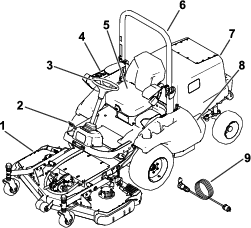
Traction Pedal
Use the traction pedal to move the machine forward or rearward.
-
Move the machine forward: Use your toes to press the top of the pedal.
-
Move the machine rearward: Use your toes to press the bottom of the pedal.
When you remove your foot from the traction pedal, the pedal should stay in a neutral position and the parking brake engages.
Note: You can achieve steady operation by keeping your heel on the platform and pressing the pedal with your toes.
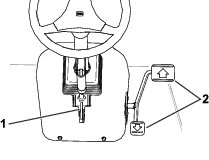
Tilt-Steering Lever
To tilt the steering wheel toward you, press the tilt-steering lever down and pull the steering tower toward you. Release the lever when the steering tower is at a position that allows you to comfortably handle the steering wheel.
Console
Refer to the following sections for a description of the console controls (Figure 18).
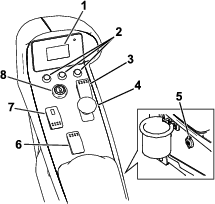
Cutting-Unit Lift Switch
The cutting-unit lift switch raises the cutting unit to the highest position (i.e., the TRANSPORT position) and lowers the cutting unit to the lowest position (i.e., the OPERATING) position.
-
Raise the cutting unit: Press the rear of the switch.
-
Lower the cutting unit: Press the front of the switch.
Raise the cutting unit to the TRANSPORT position whenever you transport the machine between locations. Lower the cutting unit to the OPERATING position whenever you are not using the machine.
PTO Switch
-
Engage the cutting unit: Pull up on the switch.
-
Disengage the cutting unit: Push the switch down.
The only time you should engage the cutting unit is when the cutting unit is in the OPERATING position and you are ready to begin operation.
Note: If you leave the operator’s seat while the PTO switch is in the ON position, the machine will automatically shut off.
Key Switch
The key switch has 2 positions: OFF and ON.
Use the switch to start or shut off the machine [refer to Starting the Machine or Shutting Off the Machine] or to review the display-screen information [refer to Understanding the Display-Screen Information].
Emergency Brake Switch
Use the emergency brake switch in an emergency such as a loss of braking. Press back the tab at the top of the switch (Figure 19), then press the front of the switch to engage the brake or press the rear of the switch to disengage the brake.

Cruise Control Switch
The cruise-control switch sets your desired speed of the machine. Move the cruise-control switch to the center position to engage cruise control. Press the switch forward to set the speed. Press the switch rearward to disengage the cruise control.
Note: Pressing the bottom of the traction pedal also disengages the cruise control. When you engage the cruise control, you can change the cruise-control speed using the display screen.
USB Port
Use the USB port to power mobile devices.
Display Screen
The display screen shows information about your machine, such as the operating status, various diagnostics, and other information.
Refer to Understanding the Display-Screen Information for more display-screen information.
Display Screen Buttons
Use the display-screen buttons to toggle between screens, navigate through menu screens, and toggle machine settings.
Note: Specifications and design are subject to change without notice.

| Description | Figure 20 reference | Dimension or Weight | |
| Height with roll bar raised | D | 200 cm (79 inches) | |
| Height with roll bar lowered | C | 111 cm (44 inches) | |
| Overall length | With equipped attachment | G | Maximum of 330 cm (130 inches) |
| Traction unit only | I | Maximum of 262 cm (103 inches) | |
| Overall width (with equipped cutting unit) | With cutting unit Model 31980 | B | 168 cm (66 inches) |
| With cutting unit Model 31981 | 198 cm, (78 inches) | ||
| Wheel-base length | E | 132 cm (52 inches) | |
| Front-wheel tread width | A | 132 cm (52 inches) | |
| Rear-wheel tread width | 122 cm (48 inches) | ||
| Ground clearance | 20 cm (7.9 inches) | ||
| Weight* | 1,012 kg (2,232 lb) | ||
| *Traction unit equipped with Model 31891 cutting unit, air-ride seat, 15 batteries, and 1 rear weight. | |||
| Battery Quantity | 11 (standard with the machine; can be equipped with 13, 15 or 17) |
| Rated Voltage | 61.5 VDC maximum and 55.3 VDC nominal usage |
| Amp Hours | 439.6 (11 batteries) |
| 519.6 (13 batteries) | |
| 599.6 (15 batteries) | |
| 679.5 (17 batteries) |
Attachments/Accessories
A selection of Toro approved attachments and accessories is available for use with the machine to enhance and expand its capabilities. Contact your Authorized Service Dealer or authorized Toro distributor or go to www.Toro.com for a list of all approved attachments and accessories.
To ensure optimum performance, use only genuine Toro replacement parts and accessories. Replacement parts and accessories made by other manufacturers could be dangerous, and such use could void the product warranty.
Operation
Before Operation
Performing Daily Maintenance
Before starting the machine each day, perform the Each Use/Daily procedures listed in .
Checking the Tire Air Pressure
Tire air pressure specification:
-
Front tires: 138 kPa (20 psi)
-
Rear tires: 193 kPa (28 psi)
Danger
Low tire pressure decreases machine side-hill stability. This could cause a rollover, which may result in personal injury or death.
Do not underinflate the tires.
Check the air pressure in the front and rear tires. Add or remove air as needed to set the air pressure in the tires to the tire air pressure specification.
Important: Maintain pressure in all tires to ensure a good quality of cut and proper machine performance.Check the air pressure in all the tires before operating the machine.
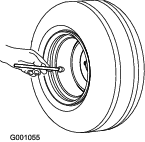
Checking the Safety-Interlock System
| Maintenance Service Interval | Maintenance Procedure |
|---|---|
| Before each use or daily |
|
The safety-interlock system prevents the machine from moving unless you are sitting in the operator’s seat. The system should also prevent the PTO from engaging unless you are in the operator’s seat with a lowered attachment (e.g., the cutting unit) and the PTO switch in the ON position.
The machine should stop moving if you are off of the operator’s seat during operation. The PTO disengages when the following occurs:
-
You are off the operator’s seat.
-
The attachment is raised to the upper limit.
-
The PTO switch is in the OFF position.
Caution
If the safety-interlock switches are disconnected or damaged, the machine could operate unexpectedly, causing personal injury.
-
Do not tamper with the interlock switches.
-
Check the operation of the interlock switches daily and replace any damaged switches before operating the machine. Perform tests in an open area away from bystanders.
-
Sit in the operator’s seat, move the PTO switch to OFF position, and remove your foot from traction pedal.
-
Rotate the key switch to the ON position. If the machine starts, proceed to step 3.
Important: If the hydraulic-pump motor does not turn on and the machine display is on, there may be a malfunction in the safety-interlock system. Refer to your authorized Toro distributor.
-
With the machine on, rise from the operator’s seat. The hydraulic-pump motor should turn off after 3 seconds. If the hydraulic-pump motor turns off, sit in the operator’s seat, raise the attachment, and proceed to step 4.
Important: If the hydraulic-pump motor does not turn off, there may be a malfunction in the safety-interlock system. Refer to your authorized Toro distributor.
-
With the machine on, lower the attachment to the ground and move the PTO switch to the ON position. The attachment should start. If the attachment starts, proceed to step 5.
Important: If the attachment does not turn on, there may be a malfunction in the safety-interlock system. Refer to your authorized Toro distributor.
-
With the attachment running, press and hold the cutting-unit lift switch to lift the attachment to the upper limit. The attachment should stop right away.
Important: If the attachment does not stop, there may be a malfunction in the safety-interlock system. Refer to your authorized Toro distributor.
-
With the machine on and the PTO switch in the OFF position, rise off of the seat until the hydraulic-pump motor stops, then press the traction pedal. The machine should not move.
Important: If the machine moves, there may be a malfunction in the safety-interlock system. Refer to your authorized Toro distributor.
Adjusting the Roll Bar
Warning
A rollover can cause injury or death.
-
Keep the roll bar in the raised locked position.
-
Use the seat belt.
Warning
There is no rollover protection when the roll bar is lowered.
-
Do not operate the machine on uneven ground or on a hill side with a lowered roll bar.
-
Lower the roll bar only when absolutely necessary.
-
Do not wear the seat belt when the roll bar is lowered.
-
Drive slowly and carefully.
-
Raise the roll bar as soon as clearance permits.
-
Check carefully for overhead clearances (e.g., branches, doorways, or electrical wires) before driving under any objects and do not contact them.
Lowering the Roll Bar
Important: Lower the roll bar only when absolutely necessary.
-
Park the machine on a level surface, ensure that the parking brake is engaged, lower the cutting unit, shut off the machine, and remove the key.
-
Remove the cotter pins and pins from the roll bar (Figure 22).
-
Lower the roll bar and secure it in place with the pins and cotter pins (Figure 22).
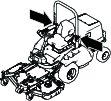

Raising the Roll Bar
-
Park the machine on a level surface, ensure that the parking brake is engaged, lower the cutting unit, shut off the machine, and remove the key from the key switch.
-
Remove the cotter pins and pins from the roll bar (Figure 23).
-
Raise the roll bar and secure it in place with the pins and cotter pins (Figure 23).
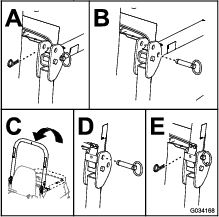
Understanding the Display-Screen Information

The display screen (Figure 24) shows information about your machine, such as the operating status, various diagnostics, and other information about the machine.
-
Splash screen (Figure 25): Shows the battery voltage and machine hour meter for a few seconds after you turn on the machine.

-
Run display screen (Figure 26): Shows the battery state of charge and other current machine information, which is shown with the icons listed in Understanding the Display-Screen Icons.

-
Blade-speed screen (Figure 27): Press the
 button
to access this screen and press
button
to access this screen and press  to adjust the cutting-unit blade speed. This
screen can only be accessed when Smart Power is disengaged.
to adjust the cutting-unit blade speed. This
screen can only be accessed when Smart Power is disengaged.
-
Traction-speed adjustment screen (Figure 28): Press the
 button to access this screen and adjust the maximum speed while
the cutting unit is in the OPERATING position
(indicated by the
button to access this screen and adjust the maximum speed while
the cutting unit is in the OPERATING position
(indicated by the  icon) or while the cutting unit is in the TRANSPORT position (indicated by the
icon) or while the cutting unit is in the TRANSPORT position (indicated by the icon).
icon).
-
Cruise control screen (Figure 29): Appears when cruise control is engaged (while you are not within an individual menu screen), or when you press the
 button with cruise control engaged.
button with cruise control engaged.
Understanding the Menu Items
To access the main menu, press the  button from any of the
main information screens.
button from any of the
main information screens.
Refer to the following tables for a description of the options available from the menus:
Note:  Protected
under Protected Menus—accessible only by entering PIN
Protected
under Protected Menus—accessible only by entering PIN
| Menu Item | Description |
| FAULTS | Contains a list of the recent machine faults. Refer to the Service Manual or your authorized Toro distributor for more information on the FAULTS menu. |
| SERVICE | Contains information on the machine such as hours of use and counts. Refer to the Service table. |
| DIAGNOSTICS | Lists various states and data that the machine currently has. You can use this information to troubleshoot certain issues, as it quickly tells you which machine controls are on/off and lists control levels (e.g., sensor values). |
| SETTINGS | Allows you to customize and modify configuration variables on the display. Refer to the Settings table. |
| ABOUT | Lists the model number, serial number, and software version of your machine. Refer to the About table. |
| Menu Item | Description |
| HOURS | Lists the total number of hours that the machine and PTO have been on, the number of hours the machine has been transported, and number of hours for hydraulic oil and axle oil. |
| COUNTS | Lists the number of PTO starts. |
TOW MODE | Allows you to engage Tow Mode; refer to Towing the Machine. |
TRACTION PEDAL | Lists the voltage values when the traction pedal is in the max forward, neutral, or max reverse positions; start a traction pedal calibration. |
| Menu Item | Description |
| TRACTION | Indicates the status of the traction system. |
| DECK | Indicates the status of the cutting unit. |
| PTO | Indicates the status of the PTO system. |
| BATTERY | Indicates the status of the battery system. |
| BATTERY PACKS | Indicates the status of individual batteries. |
| MOTOR CONTROL | Indicates the status of the electric motors and controllers. |
| CAN | Indicates the status of the machine communication bus. |
| Menu Item | Description |
| UNITS | Controls the units used on the display screen. The menu choices are English or Imperial. |
| LANGUAGE | Controls the language used on the display screen. |
| BACKLIGHT | Controls the brightness of the display screen. |
| CONTRAST | Controls the contrast of the display screen. |
| PROTECTED MENUS | Allows you to access protected menus by inputting a passcode. |
PROTECT SETTINGS | Controls the protected menus. |
SMART POWER | Turns the Smart Power® feature on and off; refer to Understanding the Smart Power Setting. |
MAX TRANSPORT | Controls the maximum machine speed while the cutting unit is in the TRANSPORT position. |
MAX MOW | Controls the maximum machine speed while the cutting unit is in the OPERATING position. |
BATT. RESERVE | Sets the remaining battery runtime (minutes) that is needed to transport the machine for recharging when the battery becomes low; refer to Setting the Battery-Reserve Capacity. |
COUNTERBALANCE | Controls the amount of counterbalance applied by the cutting-unit cylinders; refer to Understanding the Counterbalance Setting. |
AUTO IDLE | Adjusts the amount of time it takes for the hydraulic motor to reduce to low speed setting when the machine is at idle; refer to Understanding the Auto Idle Setting. |
TURNAROUND  | Turns the Turnaround mode on and off; refer to Understanding Turnaround Mode. |
| Menu Item | Description |
| MODEL | Lists the model number of the machine. |
| SN | Lists the serial number of the machine. |
| S/W REV | Lists the software part number and revision of the machine. |
| DISPLAY | Lists the software part number and revision of the display. |
| SC1 | Lists the software part number and revision of the traction motor controller |
| SC2 | Lists the software part number and revision of the pump motor controller |
| SC3 | Lists the software part number and revision of the CU1 motor controller |
| SC4 | Lists the software part number and revision of the CU2 motor controller |
| SC5 | Lists the software part number and revision of the CU3 motor controller |
| BATTERY PACKS | Lists the software part number and revision for all batteries. |
Understanding the Display-Screen Icons
Refer to the following table for a description of each display-screen icon:
 | Next |
 | Scroll up |
 | Scroll down |
 | Increase |
 | Decrease |
 | Access the menu. |
 | Exit the menu. |
 | Toggle a setting. |
 | Reset |
 | Hour meter |
 | Operator is out of seat. |
 |
Parking brake is engaged The parking brake automatically engages when the machine is in neutral or if the machine experiences a power outage. |
 | Neutral |
 | PTO is engaged. |
 | PTO is disabled. |
 | Cruise control is engaged. |
 | Cutting units are being lowered and the cutting unit is in float. |
 | Cutting units are being raised. |
 | Fast |
 | Slow |
 | PIN passcode is entered; you can access protected menu items or configure protected settings. |
 | Battery |
 | Energy-saving |
 | The traction speed or menu item is locked. |
 | Service due |
 | Counterbalance is active. |
 | Machine is charging. |
 | Machine is not charging. |
Accessing the Protected Menus
Note: The factory default PIN code for you machine is “1234”.
If you changed the PIN code and forgot the code, contact your authorized Toro distributor for assistance.
-
Select the SETTINGS option.
-
Select the PROTECTED MENUS option.
-
To enter the PIN code, press the middle button until the appropriate digit appears, then press the right button to move to the next digit.
-
After all four digits are entered, press the middle button to submit the PIN code.
If the PIN code has been entered correctly, the PIN icon will appear at the top right of all menu screens.
Understanding the Smart Power Setting
-
Smart Power engaged: The machine saves power during a light cutting load and increases performance during a heavy cutting load. This feature automatically controls the machine speed and optimizes cutting performance.
-
Smart Power disengaged: The cutting-unit blade speed is configured through the blade speed screen, and the traction speed is not limited.
Setting the Battery-Reserve Capacity
Use the battery reserve setting to set the number of minutes that you need to transport the machine to your designated battery-charging area. This allows you to have enough battery power (when the battery level becomes too low) to transport the machine for recharging.
Understanding the Counterbalance Setting
The counterbalance system maintains hydraulic back pressure on the cutting-unit lift cylinders. This pressure improves traction by transferring the cutting-unit weight to the mower-drive wheels. Decreasing the counterbalance setting can produce a more stable cutting unit but can decrease the traction capability. Increasing the counterbalance setting can increase the traction capability, but may reduce the quality of the after-cut appearance.
You can set the counterbalance to the following options:
-
Low—the most amount of weight on cutting units and the lowest weight on the drive wheels
-
Medium—medium weight on cutting units and the drive wheels
-
High—the least amount of weight on cutting units and the highest weight on machine drive wheels
-
Off—disengages the counterbalance setting
Understanding the Auto Idle Setting
When you engage auto idle, the machine draws less power from the hydraulic pump while the machine is at idle, which draws less power from the batteries and results in quieter operation.
Understanding Turnaround Mode
Turnaround mode allows you to quickly raise the cutting unit above the turf when completing a quick turn at the end of a mowing pass, or while navigating around obstacles.
When you lower the cutting unit to the OPERATING position, you can quickly press and release the cutting-unit lift switch rearward to slightly raise the cutting unit when you perform a quick turn. Once you have completed the turn, press the lift switch to lower the cutting unit back to the ground and resume mowing.
During Operation
Starting the Machine
-
Ensure that the battery-disconnect switch is in the ON position.
-
Sit on the operator’s seat and fasten the seat belt.
-
Ensure that the PTO is disengaged.
-
Ensure that the traction pedal is in the neutral position.
-
Turn the key switch to the ON position.
Resetting the PTO Function
Note: If you leave the operator’s seat while the PTO switch is in the ON position, the machine will automatically shut off.
Perform the following to reset the PTO function:
-
Push down the PTO switch.
-
Start the machine; refer to Starting the Machine.
-
Use the cutting-unit lift switch to lower the cutting unit to the OPERATING position.
-
Pull up the PTO switch.
Monitoring the Battery-System Charge Level
Refer to the main information screen in the display screen to determine the battery-system charge level.
Understanding the Low Battery-Level Advisories
-
When the battery level reaches a low percentage, a low-battery advisory appears on the display screen. Finish mowing, then transport the machine to a designated battery-charging area and charge the batteries.
-
If the battery level becomes too low while you are operating the machine, an advisory appears on the display screen. While you are operating at this battery percentage, the mower blades cannot be engaged. Transport your machine to a designated battery-charging area and charge the batteries.
Shutting Off the Machine
-
Park the machine on a level surface.
Note: The parking brake engages when the machine comes to a complete stop.
-
Disengage the PTO.
-
Turn the key switch to the OFF position and remove the key.
After Operation
Servicing the Cutting Unit
You can rotate the cutting unit from the TRANSPORT position (A in Figure 30) to the SERVICE position (B in Figure 30). Use the SERVICE position to maintain the cutting unit blades or clean underneath the cutting unit; refer to your cutting unit Operator’s Manual.
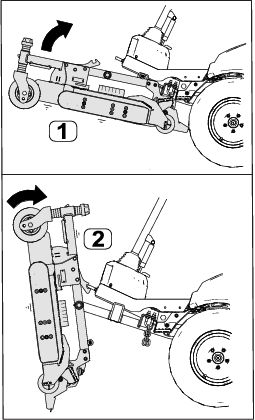
Rotating the Cutting Unit to the
Perform this procedure to rotate the cutting unit from the TRANSPORT position to the SERVICE position.
Warning
If you leave the key in the switch, someone could accidently start the machine and seriously injure you or bystanders.
Remove the key from the switch and turn the battery-disconnect switch to the OFF position; do not start the machine with the cutting unit in the SERVICE position.
-
Park the machine a level surface.
-
Press the lift switch to raise the cutting unit to the TRANSPORT position.
-
Shut off the machine, remove the key, ensure that the parking brake is engaged, and turn the battery-disconnect switch to the OFF position.
-
Remove the pins from the height-of-cut plates (Figure 31).

-
Rotate the cutting unit (Figure 32) so that the latch engages with the tie-down bracket (Figure 33).
Warning
The cutting unit is heavy.
Use assistance when you lift the cutting unit.
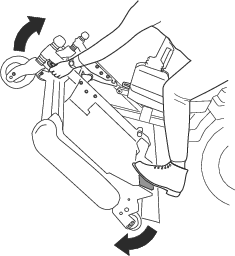
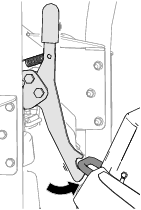
Rotating the Cutting Unit to the
Perform this procedure to rotate the cutting unit from the SERVICE position to the TRANSPORT position.
-
Release the cutting-unit latch from the tie-down bracket (Figure 34) by rotating the cutting unit slightly forward (refer to Figure 32) and pulling the latch handle forward.
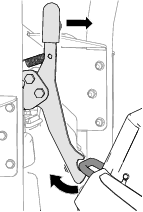
-
Slowly rotate the cutting unit down until the pin contacts the lift-arm plate (A in Figure 35).
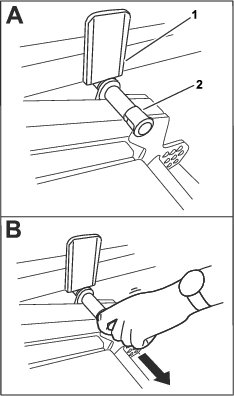
-
Use your foot to press down on the cutting unit, then pull out on the pin (B in Figure 35) to let the cutting unit settle into the TRANSPORT position.
-
Insert the height-of-cut pins through the height-of-cut plates and chains.
Transporting the Lithium-Ion Batteries
The US Department of Transportation and international transportation authorities require that lithium-ion batteries be transported using special packaging and only be transported by carriers certified to haul them. In the US, you are allowed to transport a battery when it is installed on the machine as battery powered equipment, with some regulatory requirements. Contact the US Department of Transportation or the appropriate government body in your country for detailed regulations on transportation of your batteries or the machine with the batteries equipped.
For detailed information on shipping a battery, contact your authorized Toro distributor.
Understanding the Lithium-Ion Battery Charger
Understanding Power Source Requirements
A 20 A circuit with 230V to 250V is required for full charger-output power. The charger is capable of charging between 100VAC to 240VAC, but using a power source below 230VAC results in reduced charger-output power.
Danger
Contact with water while charging the machine could cause electric shock, causing injury or death.
-
Do not handle the plug or the charger with wet hands or while standing in water.
-
Do not charge the batteries in the rain or in wet conditions.
Use the appropriate power-supply cord (for use in your geographic region) to charge the machine. Refer to your authorized Toro distributor for the appropriate cord.
If you need to use an extension cord with your power-supply cord, ensure that the extension cord has 12 AWG wires and is rated for 250 V.
Important: Check the power-supply cord periodically for holes or cracks in the insulation. Do not use a damaged cord. Do not run the cord through standing water or wet grass. Do not change the charger or the power-supply-cord plug in any way.
Warning
A damaged power-supply cord can cause an electrical shock or a fire.
Thoroughly inspect the power-supply cord before using the charger. If the cord is damaged, do not operate the charger until you obtain a replacement.
Charging the Lithium-Ion Batteries
Caution
Attempting to charge the batteries with a charger not provided by Toro can result in excessive heat and other related product malfunctions, which can lead to property damage and/or injury.
Use the Toro-provided chargers to charge the batteries.
Recommended temperature range for full-power charging: 0° to 26.6°C (32° to 80°F)
For ideal charging performance, charge the batteries in temperatures that are within the recommended full-power range. Charging the batteries in temperatures beyond the recommended range (26.6° to 40°C [80° to 104°F]) can result in reduced charging performance.
-
Park the machine in the designated location for charging.
-
Shut off the machine and remove the key.
-
Ensure that the battery-disconnect switch is in the ON position.
-
Remove the cover from the machine charger port.
-
Ensure that the machine charger port and power-supply cord are free of dust, debris, and moisture.
-
Plug the power-supply cord into the machine charger port (Figure 36).
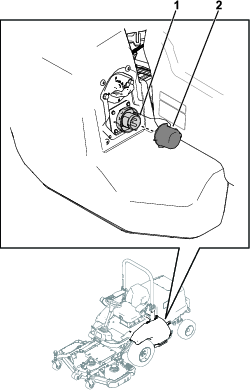
-
Insert the wall-plug end of the power-supply cord into a grounded electrical outlet.
For power source requirements, refer to Understanding Power Source Requirements.
-
Observe the display screen to ensure that the batteries are charging.
Note: The display screen shows the battery amperage and charge status (Figure 37).

-
Disconnect the chargers when the machine reaches a sufficient level; refer to Completing the Charging Process.
Completing the Charging Process
-
Remove the power-supply cord from the machine charger port.
-
Place the power-supply cord in a storage position that avoids damage.
-
Start the machine and verify the charge level using the display screen.
When charging is complete, the display screen shows 10 solid bars.
Towing the Machine
The electric parking brake automatically engages when the machine in is neutral or if the machine experiences a power outage. You must disengage the electric brake (located under the operator’s platform) via the display screen or with a lever to allow the machine to be towed.
-
Chock both sides of the front tires.
-
Perform one of the following steps to disengage the parking brake:
-
If the machine has electrical power, turn on Tow Mode in the display screen Service menu.
Note: The electric parking brake disengages when you turn on Tow Mode and the machine can move freely when you remove the chocks from the tires.If you press the traction pedal, Tow Mode disengages and the parking brake functions normally.
-
If the machine does not have electrical power, perform the following steps to manually release the parking brake:
-
Remove the lever from the operator’s manual tube.
-
Use the lever from the operator’s manual tube to loosen the nut on the platform frame (Figure 38).
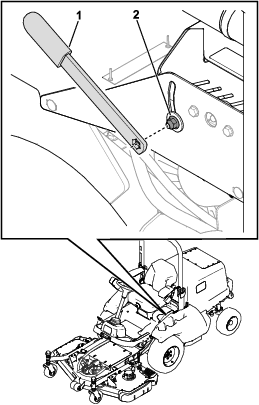
-
Place the lever on the brake-release assembly, move it up in the slot to disengage the parking brake (Figure 39), and tighten the nut to keep the parking brake disengaged while you tow the machine.
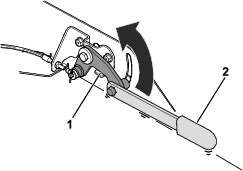
-
-
-
Remove the chocks from the wheels and tow the machine.
Important: Move the machine at a speed below 4.8 kph (3 mph) for a very short distance over flat terrain.If you must move the machine more than a short distance or over terrain that is not flat, transport it on a trailer.
-
After you have towed the machine to your intended destination, chock both sides of the front tires and perform the appropriate step to engage the parking brake:
-
If you used the display screen to disengage the parking brake, turn off Tow Mode in the display screen Service menu.
Note: The parking brake should engage when you turn off Tow Mode.
-
If you used the lever to manually disengage the parking brake:
-
Loosen the nut and use the lever to lower the brake-release assembly to engage the parking brake.
-
Tighten the nut.
-
Place the lever in the operator’s manual tube.
-
-
Hauling the Machine
-
Use care when loading or unloading the machine into a trailer or a truck.
-
Use full-width ramps for loading the machine into a trailer or a truck.
-
Tie the machine down securely.
-
Remove the key before storing or hauling the machine.
Maintenance
Note: Determine the left and right sides of the machine from the normal operating position.
Note: Download a free copy of the electrical or hydraulic schematic by visiting www.Toro.com and searching for your machine from the Manuals link on the home page.
Recommended Maintenance Schedule(s)
| Maintenance Service Interval | Maintenance Procedure |
|---|---|
| After the first hour |
|
| After the first 10 hours |
|
| After the first 50 hours |
|
| After the first 1000 hours |
|
| Before each use or daily |
|
| Every 50 hours |
|
| Every 200 hours |
|
| Every 250 hours |
|
| Every 500 hours |
|
| Every 800 hours |
|
| Every 1,000 hours |
|
| Every 2,000 hours |
|
| Yearly |
|
| Every 2 years |
|
Pre-Maintenance Procedures
Raising the Machine
Danger
Mechanical or hydraulic jacks may fail to support the machine and cause a serious injury.
-
Use jack stands to support the raised machine.
-
Use only mechanical or hydraulic jacks to lift the machine.
Raising the Front of the Machine
Important: Ensure that no cables or hydraulic components are between the jack and the frame.
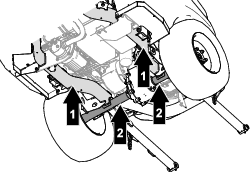
-
Chock the 2 rear wheels with chocks to prevent the machine from moving.
-
Position jacks securely under the jacking points (i.e., the frame tubes).
-
After raising the front of the machine, use appropriate jack stands under the axle tubes to support the machine.
Raising the Rear of the Machine
Important: Ensure that no cables or hydraulic components are between the jack and the frame.
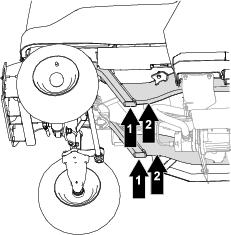
-
Chock the 2 front wheels with chocks to prevent the machine from moving.
-
Position jacks securely under the jacking points (i.e., the frame tubes).
-
After raising the front of the machine, use appropriate jack stands under thed under the machine frame to support the machine.
Lubrication
Greasing the Bearings and Bushings
| Maintenance Service Interval | Maintenance Procedure |
|---|---|
| Every 50 hours |
|
The machine has grease fittings that you must lubricate regularly with No. 2 lithium grease.
Important: Lubricate the machine immediately after every washing.
Electrical System Maintenance
Using the Battery-Disconnect Switch
-
Unplug the power cord to the machine if it is connected.
-
Move the battery-disconnect switch to the desired position as shown in Figure 46.
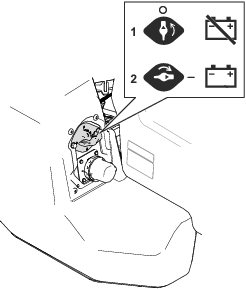
Servicing the Batteries
Note: The machine is equipped with at least 11 lithium-ion batteries. Batteries can be added with the appropriate energy expansion kits for this machine.
A lithium-ion battery must be disposed of or recycled in accordance with local and federal regulations. If a battery requires service, contact your authorized Toro distributor for assistance.
Do not open the battery. If you are having problems with a battery, contact your authorized Toro distributor for assistance
Maintaining the Lithium-Ion Batteries
Warning
The batteries contain high voltage, which could burn or shock you.
-
Do not attempt to open the batteries.
-
Use extreme care when handling a battery with a cracked case.
-
Use only the charger designed for the batteries.
The lithium-ion batteries hold a sufficient charge to perform intended work during its life span.
To achieve maximum life and use from your batteries, follow these guidelines:
-
Do not open the battery.
-
Store/park the machine in a clean, dry garage or storage area, away from direct sunlight, heat sources, rain, and wet conditions. Do not store it in a location where the temperature exceeds the range specified in Battery Storage Requirements. Temperatures outside of this range can damage your batteries. High temperatures during storage, especially at a high state of charge, reduces the life of the batteries.
-
When storing the machine for more than 10 days, ensure that the machine is in a cool and dry location, out of sunlight, rain, and wet conditions.
-
If you are mowing in hot conditions or in sunlight, the battery may overheat. If this happens, a high-temperature alert will appear on the display. In this condition, the attachment (e.g., the cutting unit) is disengaged and the machine slows down.
Immediately drive the machine to a cool location out of the sun, turn off the machine, and allow the batteries to cool fully before resuming operation.
-
Maintain the sharpness of the mower blades. A dull blade increases power consumption and reduces the amount of work that the machine performs on each charge.
-
Use lights only when it is necessary.
Maintaining the Battery Charger
Important: All electrical repairs should be performed by an authorized Toro distributor only.
The charger requires little maintenance other than protecting it from damage and weather.
-
Coil the power-supply cord when not in use.
-
Periodically examine the cords for damage, and replace them when necessary with Toro-approved parts.
Removing Debris from the Battery-Charger Compartment
Note: The battery charger is enclosed below the operator’s seat.
Remove the seat-base plate (Figure 47) and remove any debris (e.g., grass) from the battery-charger compartment.
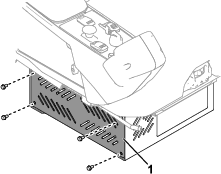
Removing Debris from the Electrical Compartment
| Maintenance Service Interval | Maintenance Procedure |
|---|---|
| Yearly |
|
Many electrical components (e.g., fuses and controllers) are located under the cover (Figure 48) on the left side of the machine. Remove the cover and use compressed air to remove any debris (e.g., grass) from this area.
Warning
Using compressed air improperly to clean the machine could result in serious injury.
-
Wear appropriate personal protective equipment, such as eye protection, hearing protection, and a dust mask.
-
Do not aim compressed air at any part of your body or at anyone else.
-
Refer to the manufacturer’s instructions for the air compressor for operating and safety information.
Important: Do not use water to remove debris from the electrical compartment, as it may damage the electrical system.
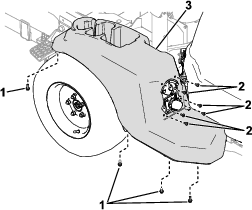
Drive System Maintenance
Checking the Axle-Oil Level
| Maintenance Service Interval | Maintenance Procedure |
|---|---|
| Every 250 hours |
|
Fluid type: Mobilfluid™ 424
-
Remove the fill plug on the axle (Figure 51).
Note: The fluid level should be even with the bottom of the fill plug.
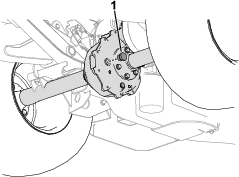
-
If the fluid level is low, remove the fill plug and add the specified fluid until it runs out of the hole.
-
Replace the fill plug and torque it to 27 to 41 N∙m (20 to 30 ft-lb).
Changing the Axle Oil
| Maintenance Service Interval | Maintenance Procedure |
|---|---|
| After the first 50 hours |
|
| Every 500 hours |
|
Fluid type: Mobilfluid™ 424
Fluid capacity: 0.68 to 0.74 L (23 to 25 fl oz)
-
Align a drain pan under the drain plug.
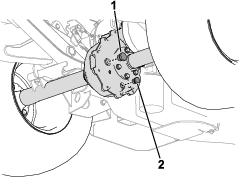
-
Remove the fill plug (Figure 52).
Note: Retain the fill plug.
-
Remove the drain plug (Figure 52) and allow the fluid to drain completely.
Note: Retain the drain plug.
-
Install the drain plug and torque it to 12 to 19 N∙m (9 to 14 ft-lb).
-
Fill the axle with the specified fluid and capacity until it is even with the fill hole.
-
Install the fill plug and torque it to 27 to 41 N∙m (20 to 30 ft-lb).
Torquing the Wheel Lug Nuts
| Maintenance Service Interval | Maintenance Procedure |
|---|---|
| After the first hour |
|
| After the first 10 hours |
|
| Every 200 hours |
|
Wheel-lug nut torque specification: 102 to 108 N∙m (75 to 80 ft-lb)
Torque the lug nuts at the front wheels in the pattern as shown in Figure 53 to the specified torque.
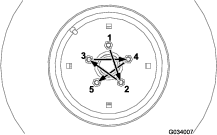
Hydraulic System Maintenance
Hydraulic System Safety
-
Seek immediate medical attention if fluid is injected into skin. Injected fluid must be surgically removed within a few hours by a doctor.
-
Ensure that all hydraulic-fluid hoses and lines are in good condition and all hydraulic connections and fittings are tight before applying pressure to the hydraulic system.
-
Keep your body and hands away from pinhole leaks or nozzles that eject high-pressure hydraulic fluid.
-
Use cardboard or paper to find hydraulic leaks.
-
Safely relieve all pressure in the hydraulic system before performing any work on the hydraulic system.
Hydraulic Fluid Specifications
The reservoir is filled at the factory with approximately 12.3 L (13 US qt) of high-quality hydraulic fluid. Check the level of the hydraulic fluid before the machine is first started and daily thereafter; refer to Checking the Hydraulic-Fluid Level.
Recommended replacement fluid: Toro PX Extended Life Hydraulic Fluid; available in 19 L (5 US gallon) pails or 208 L (55 US gallon) drums.
Note: A machine using the recommended replacement fluid requires less frequent fluid and filter changes.
Alternative hydraulic fluids:If Toro PX Extended Life Hydraulic Fluid is not available, you may use another conventional, petroleum-based hydraulic fluid having specifications that fall within the listed range for all the following material properties and that it meets industry standards. Do not use synthetic fluid. Consult with your lubricant distributor to identify a satisfactory product.
Note: Toro does not assume responsibility for damage caused by improper substitutions, so use products only from reputable manufacturers who will stand behind their recommendation.
| Material Properties: | ||
| Viscosity, ASTM D445 | cSt @ 40°C (104°F) 44 to 48 | |
| Viscosity Index ASTM D2270 | 140 or higher | |
| Pour Point, ASTM D97 | -37°C to -45° C (-34° F to -49° F) | |
| Industry Specifications: | Eaton Vickers 694 (I-286-S, M-2950-S/35VQ25 or M-2952-S) | |
Note: Many hydraulic fluids are almost colorless, making it difficult to spot leaks. A red dye additive for the hydraulic fluid is available in 20 ml (2/3 fl oz) bottles. A bottle is sufficient for 15 to 22 L (4 to 6 US gallons) of hydraulic fluid. Order Part Number. 44-2500 from your authorized Toro distributor.
Important: Toro Premium Synthetic Biodegradable Hydraulic Fluid is the only synthetic biodegradable fluid approved by Toro. This fluid is compatible with the elastomers used in Toro hydraulic systems and is suitable for a wide-range of temperature conditions. This fluid is compatible with conventional mineral oils, but for maximum biodegradability and performance, the hydraulic system should be thoroughly flushed of conventional fluid. The oil is available in 19 L (5 US gallon) pails or 208 L (55 US gallon) drums from your authorized Toro distributor.
Checking the Hydraulic-Fluid Level
| Maintenance Service Interval | Maintenance Procedure |
|---|---|
| Before each use or daily |
|
-
Park the machine on a level surface, lower the cutting unit, ensure that the parking brake is engaged, shut off the machine, and remove the key.
-
Raise the hood.
-
Remove the dipstick cap from the hydraulic tank and wipe it with a clean cloth (Figure 54).
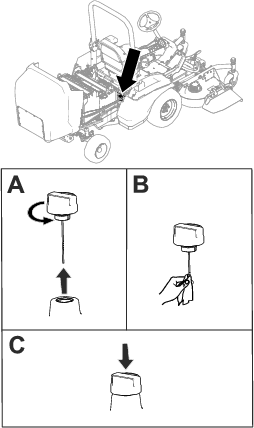
-
Insert the dipstick cap into the hydraulic tank (Figure 54).
-
Remove the dipstick cap and check the fluid level (Figure 55).

-
If the fluid level is below the appropriate lower mark on the dipstick, add the specified hydraulic fluid into the tank. Insert the dipstick cap into the tank and repeat steps 3 through 5 until the fluid level appears between the upper and lower marks (Figure 55) on the dipstick.
-
Insert the dipstick cap into the hydraulic tank and hand-tighten the cap.
-
Check all hydraulic hoses and fittings for leaks.
Changing the Hydraulic Fluid
| Maintenance Service Interval | Maintenance Procedure |
|---|---|
| After the first 1000 hours |
|
| Every 800 hours |
|
| Every 2,000 hours |
|
If the hydraulic fluid becomes contaminated, contact your authorized Toro distributor; the system must be flushed. Contaminated fluid looks milky or black when compared to clean fluid.
-
Park the machine on a level surface, lower the cutting unit, shut off the machine, and remove the key.
-
Place a large drain pan under the hydraulic-fluid pump.
-
Remove the hydraulic-tank dipstick cap.
-
Perform the following steps to drain the hydraulic fluid from the tank:
-
Fill the hydraulic tank with hydraulic fluid. For specifications, refer to Hydraulic Fluid Specifications.
Important: Use only the hydraulic fluids specified. Other fluids could cause system damage.
-
Install the hydraulic-tank cap dipstick.
-
Start the machine and use all of the hydraulic controls in the following order to distribute hydraulic fluid throughout the system:
-
Use the steering wheel to move the tires all the way to the right and left.
-
Use the lift switch to raise and lower the cutting unit.
-
-
Check for leaks and shut off the machine.
-
Check the hydraulic fluid level in the tank; refer to Checking the Hydraulic-Fluid Level.
Changing the Hydraulic Filter
| Maintenance Service Interval | Maintenance Procedure |
|---|---|
| After the first 1000 hours |
|
| Every 800 hours |
|
| Every 1,000 hours |
|
Important: Use the appropriate Toro hydraulic filter; refer to the machine Parts Catalog. Using any other filter may void the warranty on some components.
-
Clean the area around the hydraulic-filter mounting area (shown in Figure 57).
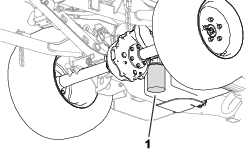
-
Place a drain pan under the filter, remove the filter, and let any remaining oil drain into the pan.
-
Lubricate the new filter gasket and fill the filter with hydraulic fluid.
-
Ensure that the filter-mounting area is clean and screw the filter on until the gasket contacts the mounting plate; then tighten the filter an additional 1/2 turn.
Checking the Hydraulic Lines and Hoses
| Maintenance Service Interval | Maintenance Procedure |
|---|---|
| Every 2 years |
|
Inspect the hydraulic lines and hoses daily for leaks, kinked lines, loose mounting supports, wear, loose fittings, weather deterioration, and chemical deterioration. Make all necessary repairs before operating the machine.
Cleaning
Cleaning the Machine
-
Park the machine on a level surface, shut off the machine, remove the key; and wait for all movement to stop before leaving the machine.
-
Turn the battery-disconnect switch to the OFF position.
-
Clean debris from the machine using water alone or with a mild detergent. You may use a rag when washing the machine. You may also use compressed air.
Warning
Using compressed air improperly to clean the machine could result in serious injury.
-
Wear appropriate personal protective equipment, such as eye protection, hearing protection, and a dust mask.
-
Do not aim compressed air at any part of your body or at anyone else.
-
Refer to the manufacturer’s instructions for the air compressor for operating and safety information.
-
Important: Do not use brackish or reclaimed water to clean the machine.
Important: Do not spray electrical components directly with water, as this may damage the electrical system.
Important: Pressurized water is not recommended when washing the machine. It may damage the electrical system, loosen important decals, or wash away necessary grease at friction points. Avoid excessive use of water, especially near any electrical components or connections.
Storage
Preparing the Machine
-
Park the machine on a level surface, shut off the machine, remove the key; and wait for all movement to stop before leaving the machine.
-
Thoroughly clean the machine and cutting unit; refer to Cleaning the Machine and the cutting unit Operator’s Manual.
-
Check and adjust the air pressure in the tires; refer to Checking the Tire Air Pressure.
-
Check the hydraulic lines and hoses; repair them as necessary.
-
Check the hydraulic-fluid level; refer to Checking the Hydraulic-Fluid Level.
-
Remove, sharpen, balance, and install the cutting-unit blades.
-
Check for loose fasteners and tighten them as necessary.
-
Lubricate all grease fittings and apply oil to pivot points. Wipe clean any excess lubricant.
-
Lightly sand and use touch-up paint on painted areas that are scratched, chipped, or rusted. Repair any dents in the metal body.
Battery Storage Requirements
Note: You do not need to remove the batteries from the machine for storage.
Refer to the temperature limits for storage in the following table:
| Storage Temperature | Appropriate Storage Time |
| 45° to 55°C (113° to 131°F) | 1 week |
| 25° to 45°C (77° to 113°F) | 3 weeks |
| -20° to 25°C (-4° to 77°F) | 52 weeks |
Important: Temperatures outside of these ranges can damage your batteries.The temperature that the batteries are stored at will affect their long-term life. Storage for long periods of time at extreme temperatures will reduce the battery life. For temperatures above 25°C (77°F), only store the machine for the appropriate amount of time indicated in the table.
-
Before you store the machine, charge or discharge the batteries between 40% to 60%.
Note: A 50% charge is optimal to ensure a maximum battery life. When the batteries are charged to 100% before storage, the battery life shortens.If you anticipate that the machine will be stored for a longer period of time, charge the batteries to around 60%.
-
For every 6 months of storage, check the battery-charge level and ensure that it is between 40% to 60%. If the charge is below 40%, charge the batteries between 40% to 60%.
-
After charging the batteries, disconnect the battery charger from power.
-
If you leave the charging cord plugged in, the charger shuts off after the batteries are fully charged and does not turn back on unless the charger is disconnected and reconnected.
